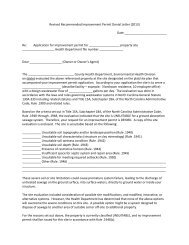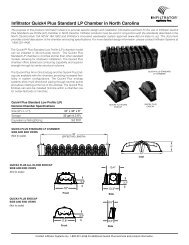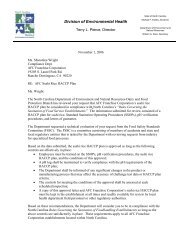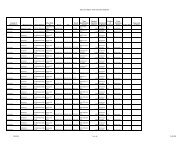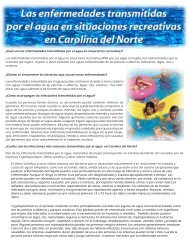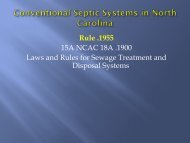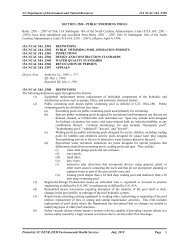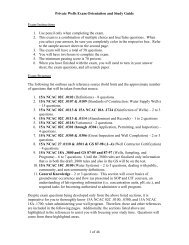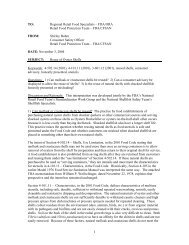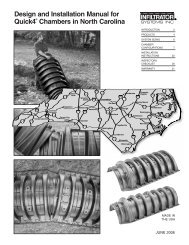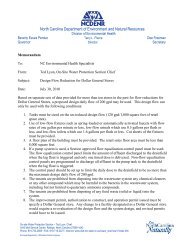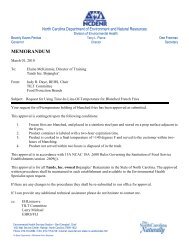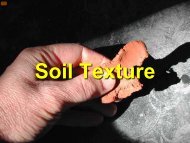Clay Mineralogy and Soil Consistence
Clay Mineralogy and Soil Consistence
Clay Mineralogy and Soil Consistence
- No tags were found...
You also want an ePaper? Increase the reach of your titles
YUMPU automatically turns print PDFs into web optimized ePapers that Google loves.
What is a Sheet?• A flat array of compounds with the samechemical arrangement joined by sharedoxygen atoms.• 2 types of sheets– Oxygen <strong>and</strong> silicon– Oxygen <strong>and</strong> aluminum• Multiple sheets make up layers
Sheet Representation• Silicon-oxygen sheet• Aluminum-oxygensheet
Layers• Sheets joined by sharing oxygen atoms• 2 types– 1:1 – 1 sheet of silicon <strong>and</strong> oxygen <strong>and</strong> 1sheet of aluminum <strong>and</strong> oxygen– 2:1 – 2 sheets of silicon <strong>and</strong> oxygen <strong>and</strong> 1sheet of aluminum <strong>and</strong> oxygen
1:1 <strong>Clay</strong>s• 1 silicon <strong>and</strong> oxygen sheet• 1 aluminum <strong>and</strong> oxygen sheet• Layers are joined by hydrogen bonding• Bonds are strong so the space betweenlayers is fixed• Little shrink or swell upon drying orwetting
1:1 LayerSilicon-oxygen sheetAluminum-oxygen sheetHydrogen atoms1:1 Layer
2:1 <strong>Clay</strong>s• 2 silicon <strong>and</strong> oxygen sheets• 1 aluminum <strong>and</strong> oxygen sheet• Layers are joined by weak oxygen-tooxygen<strong>and</strong> cation-to-oxygen linkages• Bonds are loose so other compounds suchas water can enter the structure <strong>and</strong> pushthe layers apart• Shrink <strong>and</strong> swell upon drying <strong>and</strong> wetting
2:1 LayerSilicon-oxygen sheetAluminum-oxygen sheetSilicon-oxygen sheetCalcium (cation)2:1 Layer
2:1 Layers + WaterSilicon-oxygen sheetWaterAluminum-oxygen sheetSilicon-oxygen sheetCalcium (cation)2:1 Layer
<strong>Clay</strong> Particles• < 0.002 mm in diameter• Made up of many layers– Either 1:1 or 2:1• Mostly made of 1:1 clay layers– SLIGHTLY EXPANSIVE• Mostly made of 2:1 clay layers– EXPANSIVE
THERE IS NO SUCH THINGAS NON-EXPANSIVE CLAYMINERALS!!!!SLIGHTLY EXPANSIVE <strong>and</strong>EXPANSIVE ONLY!
Why is this important?• Shrink-swell potential effects more thanjust the physical movement of clay layers• Related to soil porosity (space availablefor water <strong>and</strong> air)• If a 2:1 clay gets wet what happens?• What happens if those pores are closedup?
Relate to Septic System• The nitrification field gets dosed• <strong>Soil</strong> gets wet <strong>and</strong> pores close up• Another dose is released into thenitrification field• Where does that effluent go?• Surface?
.1941 (3)• Slightly expansive - SUITABLE– 1:1– Fixed interlayer spacing– Little shrink <strong>and</strong> swell of clays• Expansive - UNSUITABLE– 2:1– Variable interlayer spacing– Lots of shrink <strong>and</strong> swell of clays
Testing Methods• In the lab– X-ray diffraction– Atterberg Limits: liquid limit, plastic limit,plasticity index• In the field– Moist consistency– Wet consistency• Plasticity• Stickiness
Moist Consistency• Moisten sample if not already moist• Place between thumb <strong>and</strong> forefinger• Press until the sample breaks• Amount of pressure required to break thesample determines firmness
Friability• Loose• Very Friable• Friable• Firm• Very Firm• Extremely FirmMostly 1:1 claysMostly 2:1 clays
Suitable Moist Consistencies• Loose – s<strong>and</strong>-like• Very Friable – crushes under very gentlepressure• Friable – crushes under gentle ormoderate pressure• Firm – crushes under moderate pressurebut resistance is noticeable
Unsuitable Moist Consistencies• Very Firm – crushes under strongpressure, barely crushable• Extremely Firm – crushes only under verystrong pressure; cannot be crushedbetween thumb <strong>and</strong> forefinger
Stickiness• Thoroughly wet a sample of soil• Place between thumb <strong>and</strong> forefinger• Gently pull apart fingers• Amount of soil on both thumb <strong>and</strong>forefinger determines the stickiness
Stickiness• Nonsticky• Slightly Sticky• Sticky• Very StickyMostly 1:1 claysMostly 2:1 clays
Suitable Stickiness• Nonsticky – practically no soil adheres tothumb or forefinger• Slightly Sticky – soil adheres to bothfingers but comes off of one rather cleanly• Sticky – soil adheres to both fingers <strong>and</strong>tends to stretch somewhat then pull apart
Unsuitable Stickiness• Very Sticky – soil adheres strongly to bothfingers <strong>and</strong> decidedly stretches withfingers are separated
Plasticity• Thoroughly wet a sample of soil• Roll between h<strong>and</strong>s to form a wire (snake)• Wire should be 4 cm long• Pick up the wire from one end <strong>and</strong>evaluate where is breaks• The thinness of the wire determinesplasticity
Plasticity• Nonplastic• Slightly Plastic• Plastic• Very plasticMostly 1:1 claysMostly 2:1 clays
Suitable Plasticity• Nonplastic – no wire forms• Slightly Plastic – 4 cm long wire formswith diameter between 6 <strong>and</strong> 4 mm <strong>and</strong>supports its own weight• Plastic – 4 cm long wire forms withdiameter between 4 <strong>and</strong> 2 mm <strong>and</strong>supports its own weight
Unsuitable Plasticity• Very Plastic – 4 cm long wire forms with adiameter of 2 mm <strong>and</strong> supports its ownweight
In the field, how do we know wehave 2:1 clays?• Moist consistency– Very firm– Extremely firm• Wet consistency– Stickiness: very sticky– Plasticity: very plastic
2:1 <strong>Clay</strong>s are UNSUITABLEfor a septic system




